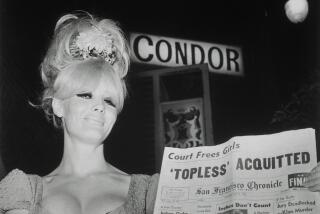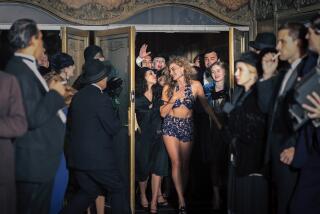Adele Jergens, 84; Blond Bombshell in Many Films
- Share via
Adele Jergens, who played brassy platinum-blond bombshells and film-noir femmes fatales in a string of B movies in the 1940s and ‘50s, has died. She was 84.
Jergens, who was a leading pinup during World War II, died Nov. 22 of undisclosed causes at her home in Camarillo.
The former New York show girl primarily played leads and second leads in 47 films, including “Ladies of the Chorus” opposite Marilyn Monroe, “The Fuller Brush Man” starring Red Skelton, “The Dark Past” with William Holden, and “Abbott and Costello Meet the Invisible Man.”
“Her image was always that of the tough chorus girl or gangster’s moll or the best friend of the lead,” said Alex Gordon, a producer at American International Pictures in the 1950s, who cast Jergens in three pictures.
“She was, you might say, a second-choice Joan Blondell type,” said Gordon. “In real life, she was just the opposite, a very sweet girl.”
Gordon used Jergens in Roger Corman’s 1956 science-fiction film “The Day the World Ended,” starring Richard Denning, Lori Nelson and Touch (Mike) Connors.
“She was a good-hearted bad girl, the girlfriend of Mike Connors,” said Gordon. “We got along so well together, I used her again in my next picture, ‘Girls in Prison,’ ” starring Denning and Joan Taylor.
Film historian Alan Rode said Jergens developed a reputation as a femme fatale in a handful of films noirs such as “Armored Car Robbery,” “Side Street” and “Try and Get Me.”
“She was one of the last links to the classic era of film-noir movies,” said Rode, who is writing a book about film-noir heavies and had scheduled an interview with Jergens just before she died.
“She was,” Rode said, “part of a bygone era of burlesque girls and men who wear fedoras -- an era where it was clear who wore the aprons at home and served the martinis to their husbands and who were the girls that the hard guys and bad men wanted to have.”
Born in Brooklyn, N.Y., in 1917, Jergens began dancing lessons at 9. Later dubbed “the girl with the million-dollar legs” by one of her dancing teachers, she began working in the chorus at the Brooklyn Fox Theater and as a Powers model.
In 1939, she was named the Fairest of the Fair at the New York World’s Fair.
Jergens, who also worked briefly as a Rockette, was named the No. 1 showgirl in New York at one point in the early ‘40s and received her first break understudying burlesque stripteaser Gypsy Rose Lee in the Broadway show “Star and Garter.”
“You know how those jobs are,” Jergens said in 1948. “All I did was stand around back- stage just in case Gypsy became ill. But those things I thought only happen in the movies, where the understudy proves to be a hit [and] wins a Hollywood contract ....”
That’s exactly what happened to Jergens. Spotted by a talent scout when she filled in for the ailing Lee for two weeks, Jergens was signed to a contract with Columbia Studios.
She made her film debut with an uncredited role in “Together Again” in 1944, then landed her first real part as a lead in a Columbia serial called “Black Arrow.”
Dubbed “The Eyeful” by a studio publicist, Jergens made something of a splash in 1945 with her first significant role, playing a princess in “A Thousand and One Nights,” starring Evelyn Keyes and Cornel Wilde.
Los Angeles Times drama editor Edwin Schallert called Jergens “a new and arresting personality in moviedom.”
In 1949, Jergens married actor Glenn Langan, her co-star in “The Treasure of Monte Cristo.” Jergens and Langan, who also appeared together in the crime drama “The Big Chase” in 1954, were married until Langan’s death in 1991.
Their only child, a son named Tracy, died last year.
More to Read
Only good movies
Get the Indie Focus newsletter, Mark Olsen's weekly guide to the world of cinema.
You may occasionally receive promotional content from the Los Angeles Times.










